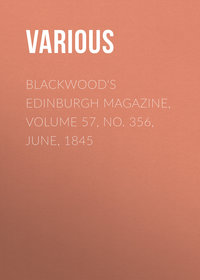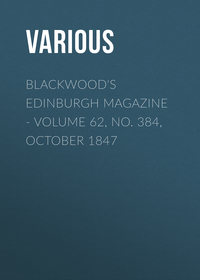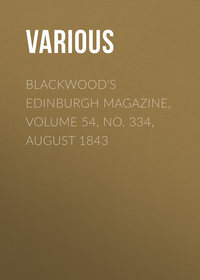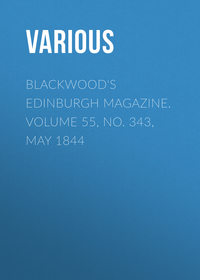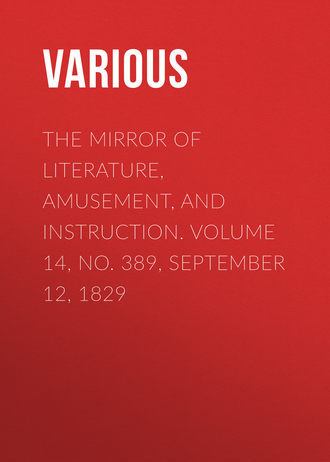 полная версия
полная версияThe Mirror of Literature, Amusement, and Instruction. Volume 14, No. 389, September 12, 1829

Various
The Mirror of Literature, Amusement, and Instruction / Volume 14, No. 389, September 12, 1829
SION HOUSE
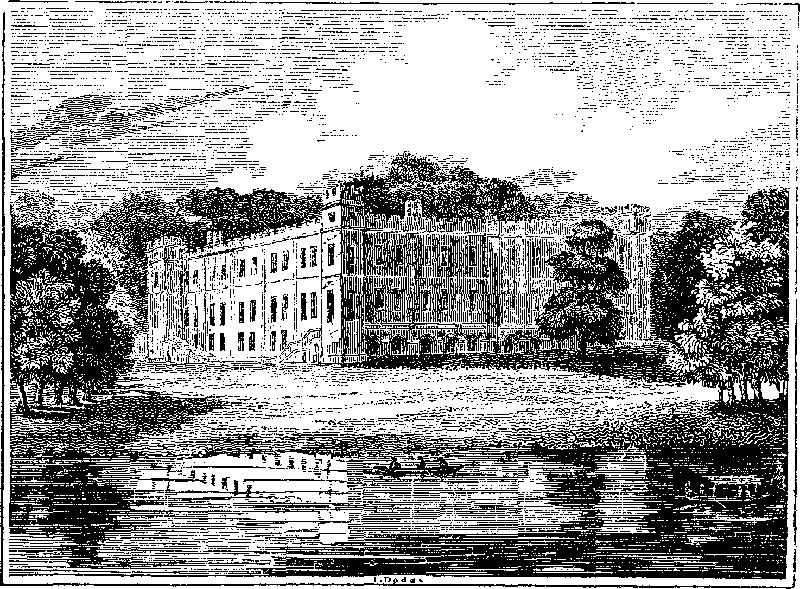
SION HOUSE.
Taylor, the water poet, or Samuel Ireland, the picturesque Thames tourist, could not, in all their enthusiasm of jingling rhymes and aquatint plates, have exceeded our admiration of Sion House. Its whitened towers and battlemented roof are known to all the swan-hopping and steam navigators of our day, and none who have floated
To where the silver Thames first rural grows,—can be strangers to the magnificence of the river-front.
Sion House stands in the parish of Isleworth, on the Middlesex bank of the Thames, and opposite Richmond gardens. It is called Sion from a nunnery of Bridgetines of the same name, originally founded at Twickenham, by Henry V. in 1414, and removed to this spot in 1432. This conventual association consisted of sixty nuns, the abbess, thirteen priests, four deacons, and eight lay brethren; the whole thus corresponding, in point of number, with the Apostles and seventy-two disciples of Christ. But the inmates were neither sinless nor spotless; many irregularities existed in the foundation, and consequently, Sion was among the first of the larger monastic institutions suppressed by Henry VIII. The estimated yearly value was 1,944l. 11s. 8-1/2d., now worth 38,891l. 14s. 2d.
After the dissolution of this convent, in 1532, it continued in the crown during the remainder of Henry's reign; and the King confined here his unfortunate Queen, Catherine Howard, from November 14, 1541, to February 10, 1542, being three days before her execution. Edward VI. granted it to his uncle, the Duke of Somerset, who, in 1547, began to build this spacious structure, and finished the shell of it nearly as it now remains. The house is a majestic edifice of white stone, built in a quadrangular form, with a flat and embattled roof, with a square turret at each of the outward angles. In the centre is an enclosed area, now laid out as a flower garden. The gardens were originally enclosed by high walls before the east and west fronts, so as to exclude all prospect; but the Protector, to remedy this inconvenience, built a high terrace in the angle between the walls of the two gardens. After his execution, in 1552, Sion was forfeited; and the house, which was given to John, Duke of Northumberland, then became the residence of his son, Lord Guildford Dudley, and of his daughter-in-law, the unfortunate Lady Jane Grey, who resided at this place when the Duke of Northumberland and Suffolk, and her husband, came to prevail upon her to accept the fatal present of the crown. The duke being beheaded in 1553, Sion House reverted to the crown. Queen Mary restored it to the Bridgetines, who possessed it till they were finally expelled by Elizabeth. In 1604, Sion House was granted to Henry Percy, ninth Earl of Northumberland, in consideration of his eminent services. His son, Algernon, employed Inigo Jones to new face the inner court, and to finish the great hall in the manner in which it now appears. In 1682, Charles, Duke of Somerset, by his marriage with the only child of Joceline, Earl of Northumberland, became possessed of Sion House: he lent the mansion to the Princess Anne, who resided here during the misunderstanding between her and Queen Mary. Upon the duke's death, in 1748, his son, Algernon, gave Sion House to Sir Hugh and Lady Elizabeth Smithson, his son-in-law and daughter, afterwards Duke and Duchess of Northumberland, who made many fine improvements here, under the direction of Robert Adam, Esq. The late duke (who distinguished himself at the battle of Bunker's Hill) passed the principal part of his time at this seat; and here, also, he died, in the year 1815. The present duke has expended immense sums in the improvement of the mansion, grounds, and gardens.
The entrance is from the great road through a fine gateway, having on each side an open colonnade, and on the top a lion passant, the crest of the noble house of Northumberland. A flight of steps leads into the great hall, sixty-six feet by thirty-one feet, and thirty-four in height, paved with white and black marble, and ornamented with colossal statues, and an extremely fine bronze cast of the Dying Gladiator, cast at Rome, by Valadier. A flight of veined marble steps leads to the vestibule, with a floor of scagliola, and twelve large Ionic columns and sixteen pilasters of verde antique. This leads to the dining room, ornamented with marble statues and paintings in chiaro oscuro, after the antique, with, at each end, a circular recess, separated by Corinthian columns, fluted, and a ceiling in stucco, gilt. The drawing room has a rich carved ceiling; and the sides are hung with three-coloured silk damask, the finest of the kind ever executed in England. The antique mosaic tables, and the chimney-piece of this apartment are very splendid, as are also the glasses, which are 108 inches by 65. The great gallery, serving for the library and museum, is 133-½ feet by 14, is in stucco, after the finest remains of antiquity, and is remarkable as the first specimen of stucco work finished in England. A series of medallion-paintings here represents the portraits of all the earls of Northumberland, in succession, and other principal persons of the houses of Percy and Seymour. At each end is a little pavilion, finished in exquisite taste; as is also a beautiful closet in one of the square turrets rising above the roof, which commands an enchanting prospect.
From the east end of the gallery is a suite of private apartments leading back to the great hall, and hung with valuable paintings, among which are the following portraits: Henry Percy, ninth Earl of Northumberland, who was implicated in the Gunpowder Plot, and imprisoned in the Tower; he died November 5, 1632, the anniversary of the day so fatal to his happiness. Lucy, Countess of Carlisle, his daughter, one of the most admired beauties of her time; she also died November 5, 1660. Algernon Percy, tenth Earl of Northumberland. Charles I. and one of his sons, by Sir P. Lely. Charles I. by Vandyke. Queen Henrietta Maria, Vandyke. The Duke of Gloucester, son of Charles I. The Princess Elizabeth, daughter of Charles I.; this is believed to be the only picture extant of this lady. The above portraits of the Stuart family are placed in the apartments in which Charles had so many tender interviews with his children, after the latter were committed to the charge of Earl Algernon Percy, and removed to Sion House, in August, 1646. The earl treated them with parental attention, and obtained a grant of Parliament for the king to be allowed to see them; and in consequence of this indulgence, the latter, who was then under restraint at Hampton Court, often dined with his family at Sion House.
Two of the principal fronts of Sion House command very beautiful scenery; for even the Thames itself appears to belong to the gardens, which are separated into two parts by a serpentine river that communicates with the Thames.
The gardens were principally laid out by Brown: they have, however, been lately improved and re-arranged; and the kitchen-garden is almost unequalled by any thing in the kingdom. Here is a range of hothouses upwards of 400 feet in length, constructed of metal, even to the wall-plates, the doors, and framing of the sashes; the whole being glazed with plate-glass. It is impossible for us to describe the extent and completeness of these improvements, connected with which, Mr. Loudon observes—"nothing can be more gratifying than to see a nobleman employing a part of his income in so judicious and spirited a manner."1
RETROSPECTIVE GLEANINGS
MONKISH VERSES
(For the Mirror.)MIRROR, vol. xii. pp. 98, 165The following is said to have been the epitaph on the tomb of Fair Rosamond, at Godstow:—
Hic jacet in tomba, Rosamundae non Rosamundi,Non redolet sed olet quae redolere solet.TRANSLATEDWithin this tomb lies the world's fairest rose;Whose scent now charms not, but offends the nose.MIRROR, vol. xiii. p. 98The couplet on York Minster, translated.
As of all flowers the rose is still the sweetest,So of all churches this is the completest.On the stone in the coronation chair in Westminster Abbey.
Ni fallat fatum, Scoti quocunque loquitur,Inveniant lapidem, regnare teneter ibidem.TRANSLATEDUnless old proverbs fail, and wizard's wits be blind,The Scots shall surely reign, where'er this stone they find.Luther sent a glass to Dr. Justus Jonas, with the following verses:—
Dat vitrum vitro, Jonae, vitro ipse Lutherus,Se similem ut fragili noscat uterque vitro.TRANSLATEDLuther a glass, to Jonas Glass, a glass doth send,That both may know ourselves to be but glass, my friend.PRIOR
MIRROR, vol. xii. p. 184Prior's epitaph on himself was parodied as follows:—
Hold Mathew Prior, by your leave,Your epitaph is very odd:Bourbon and you are sons of Eve,Nassau the offspring of a God.Which being shewn to Swift he wrote the following:—
Hold, Mathew Prior, by your leave,Your epitaph is barely civil;Bourbon and you are sons of Eve,Nassau the offspring of the devil.In the "Spectator," is part of an epitaph by Ben Jonson, on Mary Herbert, Countess of Pembroke, and sister of Sir Philip Sidney. The following is the whole, taken from the first edition of Jonson's works, collected as they were published:—
Underneath this stone doth lie,As much virtue as could die;Which when alive did vigour give,To as much beauty as could live;If she had a single fault,Leave it buried in this vault.Another on the same, from the same source:—
Underneath this sable hearse,Lies the subject of all verse,Sidney's sister, Pembroke's mother,Death ere thou hast slain another,Fair, and good, and learn'd as she,Time shall throw a dart at thee;Marble piles, let no man raiseTo her fame; for after days,Some kind woman born as she,Reading this, like Niobe,Shall turn statue and becomeBoth her mourner and her tomb.A CORRESPONDENT.The Londiners pronounce woe to him, that buyes a horse in Smith-field, that takes a Seruant in Paul's Church, that marries a Wife out of Westminster. Londiners, and all within the sound of Bow-Bell, are in reproch called Cocknies, and eaters of buttered tostes. The Kentish men of old were said to haue tayles, because trafficking in the Low Countries, they neuer paid full payments of what they did owe, but still left some part vnpaid. Essex men are called calues, (because they abound there,) Lankashire eggepies, and to be wonne by an Apple with a red side. Norfolke wyles (for crafty litigiousness:) Essex stiles, (so many as make walking tedious,) Kentish miles (of the length.)
—Moryson's Itinerary, 1617.ORIGIN OF THE WORD SMECTYMNUUS
(For the Mirror.)This was a cant term that made some figure in the time of the Civil War, and during the Interregnum. It was formed of the initial letters of the names of five eminent Presbyterian ministers of that time, viz. Stephen Marshall, Edmund Calamy, Thomas Young, Matthew Newcomen, and William Spenstow; who, together, wrote a book against Episcopacy, in the year 1641, whence they and their retainers were called Smectymnuans. They wore handkerchiefs about their necks for a note of distinction (as the officers of the parliament-army then did) which afterwards degenerated into cravats.
P.T.W.CIVIC FEAST IN 1506
(For the Mirror.)In the court room of Salters' Hall there appears, framed and glazed, the following "Bill of fare for fifty people of the Company of Salters, A.D. 1506."
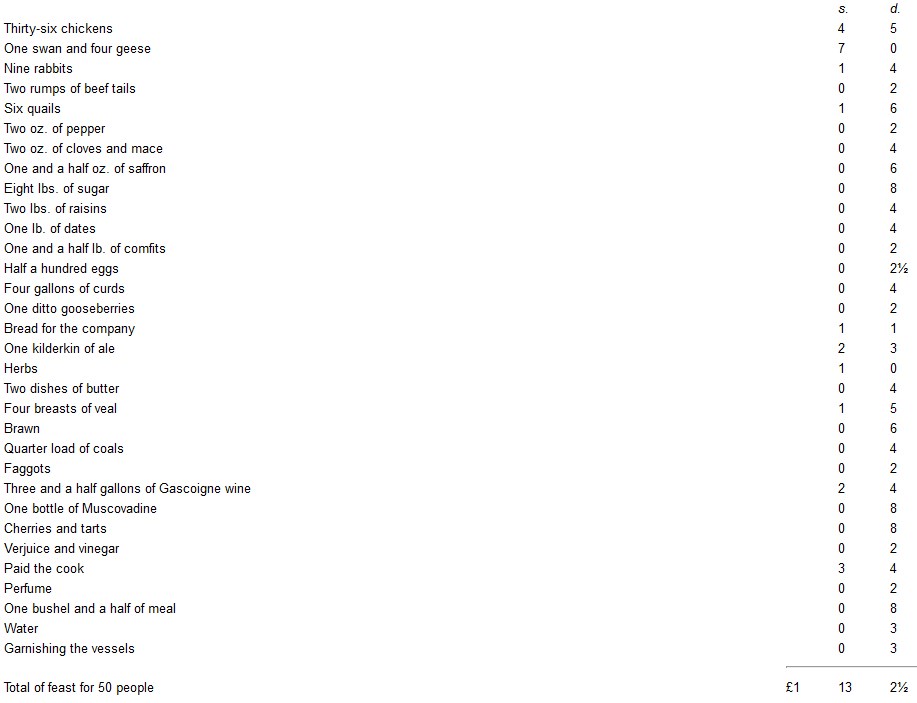
THE SELECTOR; AND LITERARY NOTICES OF NEW WORKS
VIDOCQ. (Concluded.)
We have a vulgar book called Frauds of London laid open, and Vidocq's fourth volume will serve for Paris, since he defines the nomenclature—nay the very craft of thieves with great minuteness: thus—
The Chevaliers Grimpants"The Chevaliers Grimpants, called also voleurs au bonjour, donneurs de bonjours, bonjouriers, are those who introduce themselves into a house and carry off in an instant the first movable commodity that falls in their way. The first bonjouriers were I am assured, servants out of place. They were at first few in number, but, soon acquiring pupils, their industry increased so rapidly, that from 1800 to 1812, there was scarcely a day that robberies were not committed in Paris of from a dozen to fifteen baskets of plate.
"The Almanach du commerce, l'Almanach royal, and that with twenty-five thousand addresses in it, are, for bonjouriers, the most interesting works that can be published. Every morning, before they go out, they consult them; and when they propose visiting any particular house, it is very seldom that they are not acquainted with the names of at least two persons in it; and that they may effect an entrance, they inquire for one when they see the porter, and endeavour to rob the other.
"A bonjourier has always a gentlemanly appearance, and his shoes always well made and thin. He gives the preference to kid before any other leather, and takes care to bruise and break the sole that it may not creak or make any noise; sometimes the sole is made of felt; at other times, and especially in winter, the kid slipper, or dogskin shoe, is replaced by list shoes, with which they can walk, go up stairs, or descend a staircase, without any noise. The theft au bonjour, is effected without violence, without skeleton keys, without burglariously entering. If a thief sees a key in a door of a room, he first knocks very gently, then a little harder, then very loudly; if no person answers, he turns the handle, and thus enters the antechamber. He then advances to the eating-room, penetrates even to the adjoining apartments, to see if there be any person there; returns, and if the key of the sideboard is not to be seen, he looks in all the places in which he knows it is generally deposited, and if he finds it, he instantly uses it to open the drawers, and taking out the plate, he places it generally in his hat, after which, he covers it with a napkin, or fine cambric handkerchief, which, by its texture and whiteness, announces the gentleman. Should the bonjourier, whilst on his enterprise, hear any person coming, he goes straight towards him, and accosting him, wishes him good morning (le bonjour) with a smiling and almost familiar air, and inquires if it be not Monsieur 'such a one,' to whom he has the honour of addressing himself. He is directed to the story higher or lower, and, then still smiling, evincing the utmost politeness and making a thousand excuses and affected bows, he withdraws. It may so happen, that he has not had time to consummate his larceny, but most frequently the business is perfected, and the discovery of loss only made too late to remedy it.
"The majority of the thieves in this particular line commence their incursions with morning, at the hour when the housekeepers go out for their cream, or have a gossip whilst their masters and mistresses are in bed. Other bonjouriers do not open the campaign until near dinner time; they pitch upon the moment when the plate is laid upon the table. They enter, and in the twinkling of an eye, they cause spoons, forks, ladles, &c. to vanish. This is technically termed goupiner à la desserte, (clearing the cloth).
"One day one of these goupineurs à la desserte was on the look out in a dining room, when a servant entered carrying two silver dishes, between which were some fish. Without being at all disconcerted, he went up to her, and said—'Well, go and bring up the soup, the gentlemen are in a hurry.'
"'Yes, sir,' said the maid, taking him for one of the guests, 'it is quite ready, and if you please you can announce the dinner.'
"At the same time she ran to the kitchen, and the goupineur, after having hastily emptied the dishes, thrust them between his waistcoat and shirt. The girl returned with the broth, the pretended guest had retired, and there was not a single piece of silver left on the table. They denounced this theft to me, and from the statement given, as well as the description of the person committing the robbery, I thought I had recognised my man. He was called Cheinaux, alias Bayer, and was discovered and apprehended in Saint Catherine's market. His shirt was marked with the circumference of the dishes, in consequence of the remains of the sauce left in them.
"Another body of bonjouriers more particularly direct their talents to furnished houses.
"The individuals forming this class are on foot from the dawn of day. Their talent is evinced by the adroit mode in which they baffle the vigilance of the porters. They go up the staircase, sometimes on one pretext, and sometimes on another, look round them, and if they find any keys in the doors, which is common enough, they turn them with the least possible noise. Once in the room, if the occupant be asleep, farewell to his purse, his watch, his jewels, and all that he has that is valuable. If he awakes, the visiter has a thousand excuses ready.
"'A thousand pardons, sir, I thought this was No. 13;' or, 'Was it you, sir, who sent for a bootmaker, tailor, hairdresser,'" &c. &c.
The Detourneurs and Detourneuses"The robbery à la detourne is that which is effected whilst making purchases at a shop. This species of plunder is practised by individuals of both sexes; but the détourneuses, or lady prigs, are generally esteemed more expert than the detourneurs, or gentlemen prigs. The reason of this superiority consists entirely in the difference of dress; women can easily conceal a very large parcel.
"In retail shops it would be an advisable plan, when there are many customers to serve, that from time to time the shopmen should say to each other, deux sur dix (two on ten), or else allumez les gonzesses (twig the prigs). I will bet a thousand to one, that on hearing these words, the thieves, who have very fine ears, will make haste to take themselves away.
"Shopkeepers of what class soever, particularly retailers, cannot be too much on their guard; they should never forget that in Paris there are thousands of male and female thieves à la detourne, I here only speak of robbers by profession; but there are also amateurs, who, beneath the cover of a well-established reputation, make small acquisitions slyly and unsuspectedly. They are very honest people they say, who with little scruple indulge their propensity for a rare book, a miniature, a cameo, a mosaic, a manuscript, a print, a medal, or a jewel that pleases them; they are called Chipeurs. If the Chipeur be rich, no heed is paid to him, he is too much above such a larceny to impute it to him as a crime; if he be poor, he is denounced to the attorney-general, and sent to the galleys, because he robbed from necessity. It must be owned that we have strange ideas as to honesty and dishonesty."
This is what we call Shoplifting. A milliner once told us that ribands and flowers not unfrequently attach themselves to the cuffs and sleeves of fair purchasers.
CareursBelong to the same class of thieves, and are gipsies, Italians, or Jews. The female Careurs are very expert in robbing priests; and Vidocq apprehended a mother and daughter for more than sixty such offences.
"The gipsies do not confine themselves to these means of appropriating to themselves the property of another: they frequently commit murder, and they have the less objection to commit a murder, because they have no feeling of any kind of remorse; and they have a peculiar kind of expiation whereby they purify themselves. For a year they wear a coarse woollen shirt, and abstain from 'work' (robbing). This period elapsed, they believe themselves white as snow. In France, the majority of the persons of this caste call themselves Catholics, and have every external show of great devotion. They always carry about them rosaries and a crucifix; they say their prayers night and morning, and follow the service with much attention and precision. In Germany, they seldom exercise any other calling than that of horse doctor, or herbalist: some addict themselves to medicine, that is to say, profess to be in possession of secret means of effecting cures. A vast number of them travel in bodies, some tell fortunes, others mend glass, china, pots, and pans; woe to the inhabitants of the country overrun by these vagabonds. There will infallibly be a mortality amongst the cattle, for the gipsies are very clever in killing them, without leaving any traces which can be converted into a charge of malevolence against them. They kill the cows by piercing them to the heart with a long and very fine needle, so that the blood flowing inwardly, it may be supposed that the animal died of disease. They stifle poultry with brimstone; they know that then they will give them the dead birds; and whilst they imagine that they have a taste for carrion, they make good cheer, and eat delicious meat. Sometimes they want hams, and then they take a red herring and hold it under the nose of a pig, which, allured by the smell, would follow them to the world's end."
RouletiersAre fellows who plunder carriages of portmanteaus, imperials, &c.
"One day I followed a famous rouletier named Gosnet. On reaching the Rue Saint Denis, he jumped up on a coach, put on a cloak and cotton cap which he found lying close to his hand, and in this dress got down again with a portmanteau under his arm. It was not later than two o'clock in the afternoon; but to elude all suspicion, Gosnet, on alighting, went straight to the conducteur (guard), and after having spoken to him, turned down a street close at hand. I was in waiting for him, he was apprehended and sentenced."
Tireurs,Or pickpockets are as abundant as mushrooms.
"There was in Paris a thief of such incredible dexterity that he robbed without an accomplice. He placed himself in front of a person, put his hand behind him, and took either a watch or some other valuable. This species of thievery is called the vol à la chicane.
"A fellow named Molin, alias Moulin le Chapelier, being under the portico des Français, was desirous of stealing a gentleman's purse: the sufferer, who was near the wall, thought he felt some one picking his pocket; Molin, full of presence of mind, effected his object in an instant, the purse was torn from the pocket, he opened it, and taking out a coin, asked for a ticket for the play. At the same moment the person robbed said to him—'But, sir, you have taken my purse, give it to me.'—'The devil I have,' replied Molin with an air of affected surprise, 'are you quite sure?' Then looking attentively at it—'By heavens! I thought it was mine. Oh! sir, I ask your pardon.'
"At the same time he returned the purse, and all the bystanders were persuaded that he had done it involuntarily. This is being fly, or I know nothing about it.
"At the time of the great fog, Molin and a pal named Dorlé were stationed at the environs of the Place des Italiens. An old gentleman passed, and Dorlé stole his watch which he passed to Molin. The darkness was so great that he could not discern if it were a repeater or not, and to ascertain this, Molin pressed down the spring: the hammer instantly struck on the bell, and by the sound the old man knew his watch, and instantly cried out—'My watch! my watch! pray restore me my watch, it belonged to my grandfather, and is a family piece.'
"Whilst uttering these lamentations, he endeavoured to go in the direction whence the sound had proceeded, to get his watch as he expected and hoped to do. He came close up to Molin, who, under cover of the dense fog, put his hand with the watch in it close to the old gentleman's ear, and pushing the spring again, said, whilst the watch was striking—'Listen then to its sounds for the last time;' and with this cruel advice the two thieves then went away, leaving the worthy undone elderly to bewail his loss.


